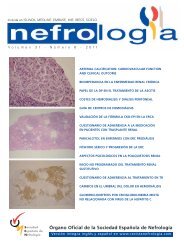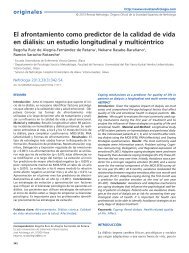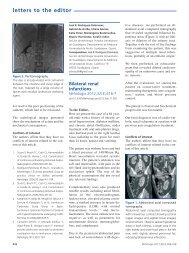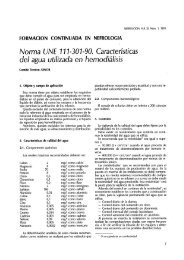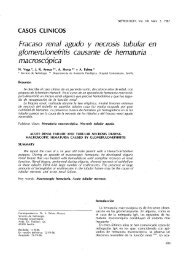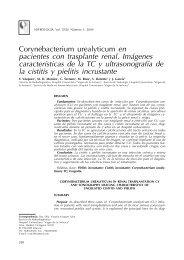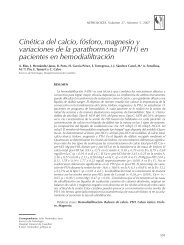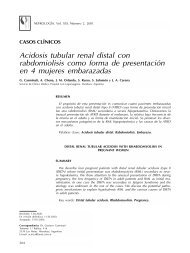PDF Número - NefrologÃa
PDF Número - NefrologÃa
PDF Número - NefrologÃa
Create successful ePaper yourself
Turn your PDF publications into a flip-book with our unique Google optimized e-Paper software.
originales<br />
Marco U. Martínez-Martínez et al. Renal function and SLE<br />
the clinical management, risk stratification and medication<br />
dosage adjustment. 2<br />
Measurement of urine clearance markers (like inulin) are<br />
the gold standard to calculate glomerular filtration rate<br />
(GFR); these methods are complex, expensive and<br />
cumbersome to perform; 3,4 the GFR predictive creatininebased<br />
equations offer a rapid method for assessing kidney<br />
function by reliance on serum creatinine and<br />
anthropometric data; these equations include: Cockcroft-<br />
Gault equation (CG), the Modification of Diet in Renal<br />
Disease study (MDRD) equation, the Mayo Clinic<br />
Quadratic (MCQ) equation and the CKD-EPI equation. 5-7<br />
Creatinine clearance (CrCl) is one other method,<br />
commonly used by rheumatologists. 8<br />
Performance of creatinine-based equations is known to<br />
vary among populations. For example, the MDRD study<br />
equation performs well in patients with chronic kidney<br />
disease, but is less accurate in potential kidney donors,<br />
young people with type-1 diabetes, and patients with<br />
substantially reduced muscle mass; 9-11 moreover, CG is an<br />
estimate of CrCl originally developed in a predominantly<br />
male, Caucasian population. 12 Conclusions of these and<br />
other studies about equations may not be appropriate in<br />
SLE, a predominantly female disease, 13 encompassing<br />
many ethnicities, 13 reduced muscle mass, 14 and with a wide<br />
range of renal function. 15 However, there is a paucity of<br />
data regarding the equations for estimating renal function<br />
in patients with SLE. 15-17 Moreover, almost half of the<br />
rheumatologists use CrCl in all of their patients in order to<br />
estimate GFR, a method with a high rate of inappropriate<br />
collection and more expensive than the creatinine based<br />
equations. 18<br />
To our knowledge, no study has determined the best<br />
equation for estimating renal function in patients with SLE,<br />
starting from iothalamate urinary clearance as gold standard.<br />
Therefore, we performed this study to evaluate which is the<br />
best equation, based on serum creatinine, to assess renal<br />
function in patients with SLE.<br />
PATIENTS AND METHODS<br />
We included, in consecutive selection, all patients with SLE<br />
according to the American College of Rheumatology (ACR)<br />
criteria. 19,20<br />
Exclusion criteria: patients under 18 years old, asthma,<br />
hypothyroidism, current smoking, malignancy, prednisone<br />
doses ≥30mg/d (or the equivalent dose of another<br />
glucocorticoid), pregnancy and severe disease activity<br />
(MEX-SLEDAI≥8). 21 All patients signed informed consent<br />
and our study was approved by the Central Hospital<br />
Institutional Review Board.<br />
100<br />
Ideal body weight (IBW) was calculated (Robinson<br />
equation). 22 Body surface index (BSI) was calculated in<br />
accordance with the Dubois equation. 23<br />
We divided this study into 2 phases.<br />
Phase 1: We measured GFR with iothalamate urinary<br />
clearance in 14 patients with SLE. GFR calculated through<br />
iothalamate was compared with the GFR estimated through<br />
cystatin and/or creatinine based equations. The main<br />
objective in this phase was to validate the best<br />
cystatin/creatinine-based equation to use at the second phase<br />
as our reference standard (Table 1). 11,24-27 We selected<br />
cystatin-based equations for this study from equations<br />
developed in other studies taking into account: studies were<br />
developed from adult patients, with more than 100 patients,<br />
and the measurement of cystatin C had been made by the<br />
same method used in our study (immunonephelometry,<br />
PENIA).<br />
Phase 2: The best cystatin/creatinine-based equation found<br />
in phase I was taken as the reference standard (measured<br />
GFR) to assess CrCl and creatinine-based equations (Table<br />
1) in 55 patients (estimated GFR). 5,7,28<br />
Laboratory tests<br />
We recalibrated serum creatinine values to standardized<br />
creatinine measurements by using the Roche enzymatic<br />
method as described elsewhere. 10,29<br />
Serum cystatin C was measured using a particle-enhanced<br />
immunonephelometric assay (N Latex Cystatin C, Dade<br />
Behring, IL). The between-day assay coefficient of variation<br />
was 3.5%.<br />
In phase 1, all patients had a non-radiolabeled<br />
iothalamate clearance using a previously described<br />
standard laboratory method. 30 In brief, after oral<br />
hydration with 4–6 glasses of water, patients received a<br />
subcutaneous injection of non-radiolabeled iothalamate<br />
(Conray ® ). Following a 1-h equilibrium period, the<br />
patient voided, the first serum sample was drawn and a<br />
timed urine collection was begun. A sonographic scanner<br />
assessed bladder emptying and a bladder catheter was<br />
placed in patients with urinary retention. Following the<br />
timed urine collection (approximately 45–60min), a<br />
second serum sample was obtained. GFR was calculated<br />
by the clearance equation (UIoV/Pio where UIo and PIo<br />
are the urine and plasma concentrations of iothalamate,<br />
and V is the urine flow) using the mean of two serum<br />
samples and one urine sample assayed for iothalamate<br />
via capillary electrophoresis. All GFR measurements<br />
were standardized for BSI (per 1.73m 2 ) by multiplying by<br />
1.73 and dividing by BSI.<br />
Nefrologia 2013;33(1):99-106



